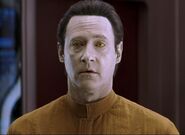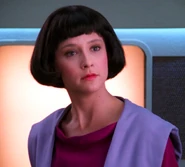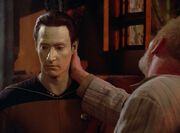
Graves recognizes Soong's work

A Soong-type android in storage
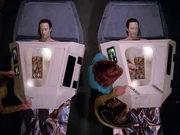
An internal comparison of two Soong-type androids
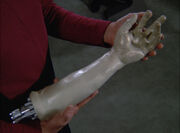
A close look at an arm from a Soong-type android
A Soong-type android was a type of android first created by the cyberneticist Dr. Noonien Soong. Soong-type androids were equipped with sophisticated positronic brains. A total of six androids were known to have been created by Dr. Soong, although only the last four had fully functional positronic brains. Dr. Soong had a lot of trouble creating the positronic brain, and it led to him gaining the nickname "Often Wrong Soong" as a result. The first five Soong-type androids were built as images of Dr. Soong in his prime, albeit with pale skin and yellow eyes (his wife Juliana Soong objected to doing so for the fifth (Data), but Noonien did so anyway). The sixth was made in the image of Juliana. For half a century, no other cyberneticist was able to replicate Soong's accomplishment, although Data came close with the creation of his daughter Lal in 2366 using a new advance in cybernetics to transfer his program into the new positronic brain. Unfortunately, it failed, and Lal was deactivated when her brain began to fail. (Star Trek Nemesis; TNG: "Datalore", "The Measure Of A Man", "The Offspring", "Inheritance") Eventually, Bruce Maddox and Soong's son Altan Soong, working together on Coppelius, were able to create sentient androids based on Noonien Soong's work. (Star Trek: Picard)
Soong-type androids were incapable of alcohol intoxication, yet components in their processing systems were susceptible to disruption by polywater intoxication. (TNG: "The Outrageous Okona", "The Naked Now")
VISORs were able to visualize a halo of energy that most Soong-type androids emanate, which is undetectable to Human senses. However, the advanced body of Juliana Tainer apparently did not do this. (TNG: "Heart of Glory", "Inheritance")
One remarkable feature of sufficiently advanced Soong-types was the ability to be upgraded to or develop true emotions that could be sensed by an empath, although there was a strong possibility of fatal neural system failure. (TNG: "The Offspring", "Inheritance"; Star Trek Nemesis)
It is apparent that Juliana Tainer was capable of true emotion, otherwise Deanna Troi would have noticed a Human that gave off no emotion at all. As for neural system failure, Tainer was not a new life that was unfamiliar with emotion but rather had the memory of an emotionally developed, fully adult Human life behind it.
Although Soong-type androids were only created centuries after, the earliest known existence of Soong-type androids was actually in the year 1893, due to the fact that the android Data was among several members of the USS Enterprise-D to be temporally marooned that year in San Francisco. Data's head would subsequently stay buried in San Francisco for the duration of several centuries until its unearthing in the 24th century. (TNG: "Time's Arrow")
The beginning groundwork for the Soong-type android was first developed in 2154 by Noonien Soong's ancestor, Dr. Arik Soong, after giving up his work in genetics and realizing that Augmentation would not enhance Humanity. Knowing that he would never see the results of his studies himself, he expected that a descendant of his in two or three generations would be the one to succeed. (ENT: "The Augments")
Other scientists over time were able to create Soong-type androids based on Altan Soong's designs. By the 32nd century, Fred was a Soong-type android who was over 600 years old. (DIS: "Red Directive")
Parts[]
Body frame[]
The body frame was composed of tripolymers which were a non-conductive material. (TNG: "Disaster") A typical Soong-type was constructed as eleven humanoid "body" sections that were then assembled to make the whole form — namely feet, lower legs with knees, one whole section consisting of the thighs up to the waist, torso, upper arms with elbows, forearms with hands, and the head with the neck. (TNG: "Datalore"; Star Trek Nemesis; PIC: "Remembrance") It was possible to at least detach the limbs while the android was functioning, and the forearms required no tools to do so. (TNG: "The Measure Of A Man") The head was capable of retaining all expected functions of that part, including speech, while detached from the body. (TNG: "Disaster") The torso was tough enough to withstand several seconds of sustained fire from a late 21st century Calico M960 handheld submachine gun. (Star Trek: First Contact)
Other components[]
- Axial servo
- Bioplast
- Chemical fuel reaction unit
- Cranial unit
- Deactivation switch
- Emotion chip
- Endoskeletal structure
- Internal chronometer
- Memory cell
- Positronic brain
- Power cell
- Self-diagnostic
- Servo fluid system
Programs[]
- Biomechanical maintenance program
- Pattern recognition
- Syntactic algorithms
- Heuristic functions (TNG: "Clues")
- Memory loss fail-safe system (Star Trek: Insurrection)
- Modesty routine which governed typical uses of clothes (created for Data, possibly copied for Lal)
- Blinking routine based on Fourier system to give the appearance of randomness (TNG: "Inheritance")
- Autonomic logs (TNG: "Phantasms")
Androids[]
The Soong-type androids created by Noonien Soong and Data, in chronological order, following Soong's first two unnamed prototypes:
Out of the seven created, four were functionally stable (B-4, Lore, Data, and Juliana Tainer), but as B-4 was simple-minded and Lore was malevolent, only Data and Tainer were truly successful, Data reaching his emotional potential with the integration of Noonien Soong's emotion chip, and Tainer being a fully developed Human mind within the most advanced Soong-type body ever created.
Appendices[]
Appearances[]
- TNG:
- Every episode except "Family" (Data)
- "Datalore" (Lore)
- "The Offspring" (Lal)
- "Brothers" (Lore)
- "Descent" (Lore)
- "Descent, Part II" (Lore)
- "Inheritance" (Juliana Tainer)
- Star Trek films
- Star Trek Generations (Data)
- Star Trek: First Contact (Data)
- Star Trek: Insurrection (Data)
- Star Trek Nemesis (Data and B4)
- ENT: "These Are the Voyages..." (Data; voice only)
- PIC:
- "Remembrance" (Data (dream) and B4 (disassembled))
- "Et in Arcadia Ego, Part 2" (Data; quantum simulation)
- LD: "Cupid's Errant Arrow" (Lal; photograph only)
Apocrypha[]
According to Star Trek Online, by the year 2409, the Federation, and by extension, the Klingons, seems to have had success in creating more Soong-type androids, as Veteran subscribers can recruit one Android Bridge Officer for their crew.
External link[]
- Soong-type android at Memory Beta, the wiki for licensed Star Trek works
- Android (robot) at Wikipedia

